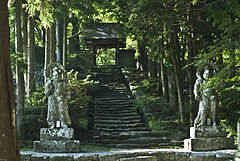|
Rokugō Manzan  Rokugō Manzan (六郷満山) refers to both a group of temples and a unique religious culture on the Kunisaki Peninsula (国東半島, Kunisaki Hantō) surrounding Mount Futago (両子山, Futago-san) in Ōita Prefecture, Japan. The Rokugō Manzan culture is said to be the birthplace of the syncretism of Shinto and Buddhist elements (Shinbutsu-shūgō, 神仏習合).[1] TerminologyRokugō (六郷) refers to the six districts of the Kunisaki Peninsula which existed at the time Rokugō Manzan was formed, the districts being Kinawa, Tasome, Aki, Musashi, Kunisaki, and Imi.[1] Manzan (満山) is a term used to describe a collection of temples.[1] When combined, the term Rokugō Manzan (六郷満山) is used to describe both the collection of Tendai sect temples on the Kunisaki Peninsula and the unique religious culture which was born in this region. HistoryAccording to the legend, Ninmon (仁聞), a legendary bodhisattva who is thought to be the incarnation of the deity Hachiman (whose main shrine is located near to the Kunisaki Peninsula at Usa Jingū), traveled to the mountains of Kunisaki to practice Buddhism.[1] It is said that during the Nara period in the year 718, Ninmon established 28 temples and created 69,000 Buddhist statues.[1] The establishment of these temples by Ninmon is said to be the origin of the syncretism of Shinto and Buddhism in Japan (神仏習合, Shinbutsu-shūgō).[1] Although this story is legendary, the mountain valleys of the Kunisaki Peninsula and the Rokugō Manzan temples, along with the nearby Usa Jingū, are widely believed to be the birthplace of shinbutsu-shūgō.[1][2] The Rokugō Manzan religious culture has a history of more than 1,300 years with several of the Kunisaki Peninsula's Tendai sect temples being similarly old. How exactly the Rokugō Manzan temples were actually established remains mostly unknown due to a lack of records from the time. Usa Jingū, located at the base of the Kunisaki Peninsula, played a major role in the origin of shinbutsu-shūgō and has strong historical connections to the Rokugō Manzan temples. It is said to have been the earliest example of jingū-ji, or "mixed shrine-temple complex" with the former Miroku-ji (弥勒寺) having been built on the grounds of Usa Jingū to form Usa Hachimangu-ji (宇佐八幡宮寺).[3][4] Shinbutsu-shūgō eventually spread throughout Japan and was prominent until the policies of shinbutsu bunri(神仏分離) were put into effect after the Meiji Restoration.[5] These policies enforced a separation of Shinto and Buddhism, and Miroku-ji along with most Buddhist elements at Usa Jingū were destroyed or removed in accordance.[3] However, many of the influences of shinbutsu-shūgō can still be seen in the many Rokugō Manzan temples.[6]  TemplesThe most central of the Rokugō Manzan temples is Futago-ji (両子寺)which is more than 1,300 years old and is located on Mount Futago.[1] Other important Rokugō Manzan Buddhist temples and sites in the area include:
References
|